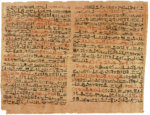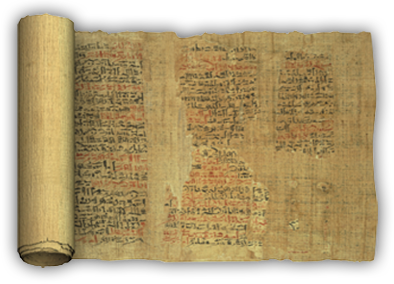

First, I was taught and I did teach the Hippocratic tenet, ‘ Primum non nocere‘ (First do no harm). ‘Father of Medicine’ in the Internet Age, Helen King puts forth a conjecture that the recent desire to label Imhotep ‘Father of Medicine’ in the place of Hippocrates is “to reverse a valorization of West over East which has been common in histories of medicine into the twentieth century.” Certainly that has also been true with regards Chinese medicine and scientific advances, often superior to Western thought and technology of past eras, but which have only come to be acknowledged in recent decades.

Unfortunately, while the front of the papyrus deals with the care of wounds, beginning with the head, the verso has magical spells to exorcise demons.

In it the text instructs the physician to examine the patient and elicit physical signs that may indicate the prognosis. The Edwin Smith Papyrus has also been proffered as “proof” that it reflects a rational evidence-based approach to medical healing. It is believed to be a compilation of older writings but parts of it existed during Imhotep’s lifetime and could reflect his approach to medicine and magic. The most important of the papyrus rolls is the Ebers Papyrus, written circa 1550 BC. These have included the Ebers Papyrus, the Hearst Papyrus, the Berlin Medical Papyrus, the Kahun Medical Papyrus, the London Medical Papyrus, the Edwin Smith Papyrus and another papyrus in Berlin. Much of what is known about ancient Egyptian medicine is found in a handful of papyrus rolls. The first mention of his medical credentials dates to 2,200 years after his death. So great was respect for Imhotep that he was deified a few centuries after his death. What does stand scrutiny, however, is that Imhotep was the chancellor to the Pharaoh, Djoser, architect of the step-pyramid at Saqqara and royal astronomer. The Dictionary of World Biography states, “while the specific qualifications of Innotek (Imhotep) as a healer are not as clearly documented, it is thought that his duties as a priest who was regarded as a magician may have initiated his reputation as a medical man.” Even the Wikipedia page dedicated to Imhotep found the claims for his having been a physician unreliable.

In addition, the first citation I looked up from that article did not exist. When I went back to review the paper from Consultant 360, I noticed that there was no author. Nevertheless, there are genetic (i.e., the Akhenaten gene) and linguistic links from the Copts to the ancient Egyptians.įurthermore, searching for evidence of Imhotep’s medical credentials has proved to be elusive. Unfortunately, “proof” that the Copts are the descendants of the ancient Egyptians is somewhat controversial. In 2012, I read an article in Consultant 360 titled, “Imhotep: The Physician/Architect Who Led Us From Magic to Medicine.” As I was baptized in the Coptic Catholic church, I have always believed that the Copts are descendants of the ancient Egyptians and, therefore, strongly felt the link to Imhotep. The hieroglyph and statue are both of Imhotep (“He who comes in peace”), circa 2667-2600 BC. You may have noticed that this website has an ancient Egyptian motif. “The first figure of a physician to stand out clearly from the mists of antiquity” sir william osler


 0 kommentar(er)
0 kommentar(er)
